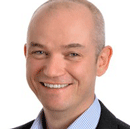ATS Stockholm, 24 May 2012 Wrap-Up
by Romany Reagan on 30th May 2012 in News

RTB and programmatic buying are quite nascent in the Nordics. At last week’s ATS Stockholm there was much discussion about where to begin and how to edge the region into the forefront of an already established global RTB environment.
INTRO: The day kicked off with an introduction by IAB Sweden (IAB Sverige) CEO, Charlotte Thür who gave us some interesting stats for the Nordics:
- IAB Sweden was founded in September 2008
- For mCommerce sales in select countries in Europe, according to eMarketer.com, Sweden has grown from 1.8% of online sales in 2010 to 7.8% of online sales in 2012
Current ad spend in Sweden is 2.2bn SEK (£19.6m), of which:
- 36% search
- 35% display
- 28% online catalog
- 1% email marketing
 KEYNOTE 1: Our first keynote speaker of the day was Gustav Mellentin, Co-Founder & CEO, Adform, who told us: it’s not about real time bidding, it’s about real time advertising.
KEYNOTE 1: Our first keynote speaker of the day was Gustav Mellentin, Co-Founder & CEO, Adform, who told us: it’s not about real time bidding, it’s about real time advertising.
The current trading models of open auction and private auction are working well, but proposed simplifying the process by posing the question: why can’t everything be traded on fixed price? Either way, RTB technology is here to stay, stop fighting it!
PANEL 1: The first panel discussion was between Johan Pettersson, Digital Director, Starcom Sweden; Jukka Sundquist, Head of Display, Partner, Klikki; Simone Skoog, Managing Director Nordics, Criteo and Peter Loell, Director, Annalect, Omnicom MediaGroup, moderated by ExchangeWire’s Paul Silver. The panel focused on the inception of automated trading in the Nordics, breaking down the history of automation in other regions and the Nordic reaction to the new technology available.
Everyone agreed it's about audience buying, not media buying -- but the technology and efficiency need to step it up.
Peter Loell posed the question, there are three levels to adoption: shock, denial and acceptance -- where are the Nordics now? In the theme of threes, he also broke down a projected evolution for programmatic buying. In the Nordics right now it is more “problematic” buying than programmatic -- but if the region wants to scale, they’re going to have to be more focused on pragmatic buying.
![]() KEYNOTE 2: Oliver Whitten, VP & Commercial Director, EMEA, Rubicon Project, brought us our next keynote with some impressive numbers to share in his presentation “Rise of the machines! Real time trading goes mainstream.”
KEYNOTE 2: Oliver Whitten, VP & Commercial Director, EMEA, Rubicon Project, brought us our next keynote with some impressive numbers to share in his presentation “Rise of the machines! Real time trading goes mainstream.”
In his introduction, Oli included an interesting Google statistic which outlines the growth of demand coming into the marketplace:
“Year on year display spending from our largest 1,000 advertisers has doubled.” - Brad Bender, Director of Product Management, Display Google c2011
Whitten projected some sad news as automated trading looks to be the death of the “three martini lunch”, however he stressed the remaining importance of the human element, however perhaps relegated to larger events rather than a Mad Men immediacy necessary in human contact. (We hope there will still be martinis though!)
He further explained the need to evolve the display-buying process, pointing out the systemic inefficiencies of the manual model that currently commands on average 15 hours per buying point per plan. He also referenced if digital advertising is to scale to the heights of TV, we have to address the 28% versus 2% inefficiencies in executing a buy.
Whitten also gave us a brief synoptic timeline of automated trading through the ages:
- mid-1990s: manual buying on a small handful of sites
- early-2000s: manual buying on thousands of sites
- mid-2000s: increased reliance on undifferentiated networks, millions of sites from which to choose
- late-2000s - now: automated buying now necessary to handle the sheer volume and desired reach
Some Nordic RTB growth facts:
- 470% growth year on year
- Sweden & Denmark leading the field
- 28% of bid revenue at greater than 35 SEK
- Denmark has highest CPMs
Whitten ended his presentation with a surprise announcement! The Rubicon Project has just partnered with Sweden’s Netric Sales in a collaboration to help publishers use neworks more effienctly in the Nordics.
PANEL 2: Our next panel, moderated by ExchangeWire’s Ciaran O’Kane, saw Ola Tiverman, CEO, Admeta; Simon Halstead, Director, Microsoft Advertising Exchange, EMEA, Otto Neubert Block, CEO, Emediate, and Patrik Sandberg of Nyheter24-Gruppen discussing the preparation of publishers for automation and data-driven advertising.
Simon Halstead stressed the importance of “fail big - fail quick” in order to learn. If you test too small, you don’t make big enough mistakes to learn from the experience -- whether you’re Microsoft, or a start-up -- Halstead stresses the trial and error model to be key.
Sandberg was emphatic that his business’ focus is very much on the growth opportunity. Not necessarily migrating existing demand from a direct to non-direct sales channel, but bringing in new revenue into his marketplace, namely brand budget from traditional mediums.
 KEYNOTE 3: Giving us the video perspective, Brian Fitzpatrick, Managing Director, Europe, Adap.TV discussed how video RTB differs from display RTB.
KEYNOTE 3: Giving us the video perspective, Brian Fitzpatrick, Managing Director, Europe, Adap.TV discussed how video RTB differs from display RTB.
TV and online video are coming together: of the 2010 full year display total of £1,128 - online video equals 10% (£109m) of display media, banners 52% (£585m).
Online video has doubled year on year:
- 2008: £12m
- 2009: £28m
- 2010: £54m
- 2011: £109m
Diminished reach of TV:
Compared to 10yrs ago, one TV spot reached the same amount of people it takes eight TV spots to reach today.
Apps are becoming the new TV:
Gaming apps are garnering larger audiences than TV during Nielsen’s “sweeps” month analysis, with Cityville and The Sims Social leading with over 30 million viewers/players.
Which video metrics are becoming more meaningful to marketers?
Brand lift has seen the most dramatic increase, of 54% so far for 2012 compared with only 18% in 2011. We also saw significant growth in the use of GRPs and TRPs, which are now being actioned within the Adap.TV platform.
Where are advertisers buying their video inventory in 2012?
- 72% direct from publishers
- 73% ad networks
- 29% exchanges
- 32% DSPs
- 27% trading desks
(with 82% of ad networks sourcing through exchanges)
FIRESIDE: After lunch, we began with a very lively fireside chat, between Burt’s Gustav von Sydow and ExchangeWire’s Ciaran O’Kane, discussing the future of display in the Nordic region. While von Sydow is a firm believer in branding, O’Kane in his typical devils advocate role, didn’t think it works, much preferring hard numbers you can analyse and monetise, feeling the realm of branding a little fluffy -- to which von Sydow delicately asked, “Maybe we shouldn’t start a conversation with ‘You Suck?’”
 KEYNOTE 4: Our next keynote speech was delivered by Nigel Gilbert, Director of Sales, EMEA, Appnexus, giving us some background information on where RTB was not that long ago, and how Appnexus aims to bring global regions, including the Nordics, into the future.
KEYNOTE 4: Our next keynote speech was delivered by Nigel Gilbert, Director of Sales, EMEA, Appnexus, giving us some background information on where RTB was not that long ago, and how Appnexus aims to bring global regions, including the Nordics, into the future.
Gilbert opened with a great quote, that reminds us how far we’ve really come, and quickly, compared to thoughts on automation ten years ago:
“What you’re trying to do is impossible.” - Dwight Merriman, CTO DoubleClick, c 2002
Gilbert further announced Appnexus no longer considers themselves a platform, but has now evolved more to what they consider an “ecosystem”, built with open APIs for additional customisation of user interface, bidder, data extraction, optimisation engine and hosting environments.
So what’s in store for the future?
Appnexus offers rich media & creative templates:
- Comprehensive rich media support: expandables (standard or video), interstitials (standard or layer) and video (VAST in-line or wrapper)
- Broad range of display: YouTube, Microsoft, Technorati, Collective and more
And the opportunity to work with the vendor of your choice:
- Preset templates for popular vendors and you can also create custom templates
Gilbert also announced Appnexus’s new App Marketplace, which he stressed is not really a “marketplace” at all, as all the apps are available free of charge.
PANEL 3: I think everyone agreed the last panel of the day was the most intense, seven speakers total on stage, and a lot of opinions flying about, the Twittersphere really perked up for this one!
Focusing on technology and targeting: empowering buyers and sellers with real-time tech and targeting solutions, the panel was moderated by ExchangeWire’s Ciaran O’Kane and Paul Silver, with panelists including: Shane Shevlin, Director of Business Development, Iponweb; Kate Owen, Managing Director, Europe, Digital Element; Josh Mortensen, Founder and Managing Partner, GlibHippo; Petteri Vainikka, Founding Partner & VP Marketing, Enreach and Greg Williams, Co-Founder and VP Business Operations, EMEA, MediaMath.
The highlight of this vibrant volley of ideas was definitely when Paul Silver suggested there has been talk of trading ad space as futures -- to which you could physically see the panel shrink back in scepticism with only MediaMath’s Greg Williams launching forward in his seat quite excited by the prospect.
 KEYNOTE 5: Our last keynote of the day was delivered by Jason Bigler, Product Development Director for EMEA, Google, discussing the need for a unified platform to simplify the process and improve efficiency for all sides involved. Automated activities at each stage of the media buying lifecycle help to improve efficiency and productively, from buying to creating, to traffic and reporting -- with homogenisation across all channels being presented as the way forward.
KEYNOTE 5: Our last keynote of the day was delivered by Jason Bigler, Product Development Director for EMEA, Google, discussing the need for a unified platform to simplify the process and improve efficiency for all sides involved. Automated activities at each stage of the media buying lifecycle help to improve efficiency and productively, from buying to creating, to traffic and reporting -- with homogenisation across all channels being presented as the way forward.
Only with a unified platform can you anticipate the audience journey, deliver engaging creative across channels, devices, in real time, billions of times a day.
“By 2015, 50% of all display spend will be bought programmatically.” - Neal Mohan, VP Display, Google
Create long-term value through differentiation: integrate your own third party data, customise your own technology, your own business models, your own expertise and access audiences across geographies, formats and devices.
What do publishers need? One platform with three goals: maximise revenue, capture new opportunities and improve efficiency.
Google’s New for Q2:
- Direct deals martketplace: Package your inventory, solicit offers from multiple buyers, negotiate, and execute, all without sending an email or picking up the phone.
- Network partner management: easily manage and grow publisher networks of any size, quickly understand partner performance for better monetisation
- Dynamic Allocation - dynamically decision whether an impression should be optimised via a direct or non-direct sales channel according to the yield it will generate on every individual impression.
The day ended with a ePrivacy to-cookie or not-to-cookie showdown between 201 Connected Media founder Wouter Hulst and ExchangeWire’s Ciaran O’Kane -- we were already over time but everyone still had a lot to say so the debates raged on over drinks and canapes hosted by Burt.
To take a peek at the real time conversation on the day, search our Twitter hashtag #ATSST
Some Twitter highlights:
Jukka Sundquist @csoccer
#atsst "Don't test too small, you have to fail for to be able to learn", Simon Halstead, Microsoft
Romany Reagan @msromany
"We're applying an engineering solution to a people problem." @razzmuzzen Yes!! #atsst
Brian Madsen @brianmadsen
The speed of light isn't quick enough! #RTB #ATSST
Paul Silver @thepaulsilver
Automated buying is simply about stripping out waste, improving ad matching. End of. According to #adform #atsst
Andreas Wiberg @andreaswiberg
Swyd & Dwys! What a fresh perspective from @wouterhulst #atsst
MediaMath EMEA @MediaMathEMEA
A great day yesterday for #ATSST Stockholm! Well done@ExchangeWire ...:-)
Admeta @AdmetaCompany
Thank you all for a fantastic well coordinated, interesting and well executed conference! #ATSST #RTB @exchangewire
Ad NetworkAd ServerAgencyAnalyticsCreativeDisplayDMPDSPExchangeNordicsProgrammaticPublisherTradingTrading Desk








Follow ExchangeWire